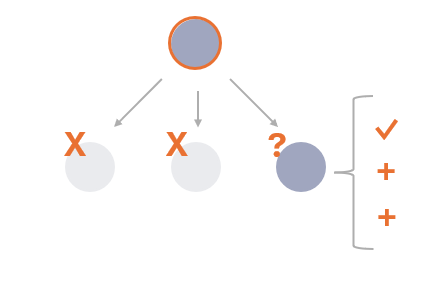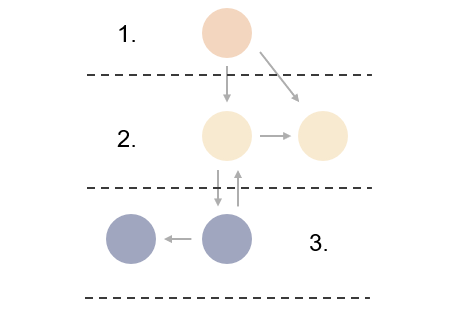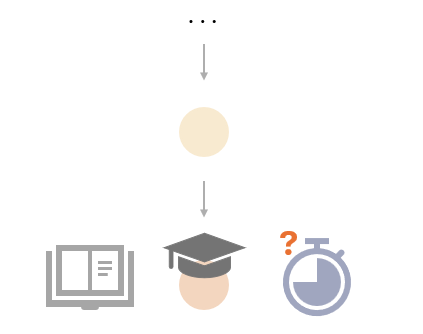You have written and submitted your quals paper, and have scheduled your student-prepared exam with your quals committee. Congratulations! You are half-way done. However, the exam you will be evaluated for includes not only the paper you submitted, but also the presentation and question-and-answer session on the day of your exam. This article will demystify the student-prepared oral exam and share best practices.
Note: This article was published in January 2025. What is described here as “Part I” is now known as “the student-prepared section” and consists of a paper and a presentation about the paper. As of fall 2023, the student-prepared section happens after the faculty-prepared section of the exam (formerly known as “Part II” or the oral exam). We will update this article in anticipation of the new quals format being rolled out in the 2024-25 academic year.
Disclaimer: The content of this article does not represent or replace the voice of the NSE faculty. The Comm Lab is a peer resource, so make sure to consult with the Academic Administrator (currently Brandy Baker), Quals Coordinator (currently Zach Hartwig), or your PI for official guidance.
1. The quals presentation at a glance
1.1. What it is
The quals presentation, like the faculty prepared portion, is ultimately an exam. The goals of this exam are to assess your:
- ability to think logically, express a point of view, and defend it orally.
- knowledge of a specialized field of research.
- knowledge of the technical foundations of the field of research, including the ability to make connections and integrate across those foundations.
(from NSE Doctoral Degree Requirements)
Ultimately, it is a forward-looking presentation where you demonstrate how you will solve a novel problem in your field of research.
1.2. What it is NOT
The quals presentation is NOT your standard research presentation, like one that you would give at a conference, where the goal is to communicate the results of research you have already performed. It is not exclusively a backward-looking presentation to demonstrate all that you have accomplished.
One goal of the quals presentation is to demonstrate your technical knowledge and ability to perform research. Particularly, if you have finished a masters or related extended research program, your past experience can showcase the research skills that you have developed and is a great resource to draw from in your presentation. However, showcasing your past experience and existing skills is only part of what you need to accomplish in your quals presentation. A quintessential facet of the exam is demonstrating your ability to develop a research program to investigate a novel problem.
1.3. The focus of your presentation
The aim of your presentation, then, should be to identify a key unanswered question, and convince your committee that this research topic is an important problem worth investigating and that you have an achievable plan to investigate it.
2. Before making slides
2.1. Review department guidance
This guide is ultimately a peer resource. Consult official requirements for the quals presentation. Also talk to your advisor. While they cannot give you specific feedback on the content of your presentation, they are familiar with well-planned and impactful research and how to communicate it. Your advisor wants to see you succeed!
2.2. Consider your audience
Your audience is ultimately your quals committee. Your committee will include your advisor(s), who should be very knowledgeable of the specifics of your research, as well as other faculty who will be generally knowledgeable on topics in Nuclear Science and Engineering. Make sure your presentation strikes a balance for committee members in your area of research and those outside it. A successful presentation brings everyone up to speed on the relevant topics in your field, so that they understand the advanced topics you will explore.
2.3. Identify the open question that you will tackle
The department gives some flexibility concerning the research project that you discuss in the prepared section of your qualifying exam. However, make sure you emphasize the novelty of your research plan regardless of the project you are presenting.
“Part I: the student will present a 5-10 page original paper prepared in advanced and submitted no less than 10 days prior to the oral exam date. The paper should review a field of research, critique it, and formulate a research plan to approach a specific problem in the chosen field. The examining committee will evaluate the content of the paper, the student’s understanding of it, and the quality of the presentation.”
(From PhD Requirements, Emphasis by NSE Comm Lab)
Many students choose to present their planned PhD project, which can become the basis for their thesis prospectus later on. Whether you choose this option or decide to expand on your master’s thesis work, make sure that you cover all the content that is asked of you (highlighted above). Consult with your PI to make sure you are on the same page, but remember that this is your project. You will be responsible for its planning, execution, and progress.
3. Making your presentation
3.1. How to Structure your presentation
Not all presentations looks the same, but most include these parts:
Relevant background to contextualize the problem you are studying. Your goal should be to explain the underlying science / engineering of your area of research in order to identify an unsolved problem / unanswered question.
Motivation to convince your committee that this problem is worth solving. Outline benefits (both in your specific area of research and for the field as a whole) of exploring this topic.

Why is this problem worth solving? Why should you solve it the way you are proposing? In addition to identifying and motivating the question you want to answer, an effective presentation will also review alternative approaches to the problem. When reviewing alternatives, identify why the one you identify is worth further investigation.
A research plan to demonstrate to your committee that you can investigate the identified problem to produce meaningful results. An important aspect of explaining your research plan is demonstrating that you are able to formulate a program to investigate an open-ended research question through a series of actionable steps. This is where your existing research experience comes in. Your goal is to turn a novel research question into a series of discrete objectives and milestones that offer meaningful chances to publish results and assess the project as a whole. Ideally, you will present a number of tasks, that being completed, will result in an answer to the question you identified and is worthy of a PhD. A convincing quals presentation will demonstrate to your committee that you have the necessary skills to complete those tasks.

How will you turn an open question into a coherent research plan? Break your large question into discrete phases or action items that together offer an answer to your research question.
Expected outcomes to identify what success will look like for your project. You are pitching a research plan that will culminate in you finishing a PhD. You can always acquire more results and continue research. By providing a definitive scope of your project and identifying a meaningful stopping point, you can demonstrate to your committee that your identified topic is also a good PhD topic.

What does the end of your project look like? When does ongoing research turn into a finished thesis? Identify key outputs (particularly potential points to publish) and propose a timeline for finishing all the work.
What does the end of your project look like? When does ongoing research turn into a finished thesis? Identify key outputs (particularly potential points to publish) and propose a timeline for finishing all the work.
3.2. The content of your presentation
What information should you include in your slides? First, review your submitted quals paper and identify key points to sell your project. 15-minutes is a short time, so you want to focus on the most important aspects of your paper. What problem are you solving? And what information does your committee need to understand the technical aspects and the significance of that problem?
Be careful! Identify necessary content that you are confident in explaining, elaborating, and defending. The quals presentation is an exam and your committee is free to question and dive into everything on your presented slides. Before including a figure, equation, or any information, ask yourself:
- Do you understand the relationship or mechanism being depicted?
- Could you derive any relevant equations?
- Could you identify key terms and assumptions that produced the graph/equation/relationship?
The quals presentation is not the time to show off. The material you present should be material you are an expert in. You should be able to defend any presented material as if it were your own. Your project may have exciting, far-reaching but not well understood implications. There may be field-specific buzzwords that would attach nicely to your project. If you could not explain a piece of information on your slides several levels deeper than how you wish to present it, consider not including it in your presentation.
3.3. Back-up Slides
Create many backup slides: the presentation consists of 15-minutes of prepared presentation and 45-minutes of questions from your committee. Anticipate questions your committee could ask / areas beyond your focused presentation that might be explored and prepare slides for them. Back-up slides are the perfect place for important information that did not make it into the main presentation.
Your main presentation should focus on a coherent narrative explaining a research topic, the background information needed to understand that topic, and a program to explore that topic. These are pieces of information necessary to understand and motivate the project you are proposing. More nuanced information that does not directly relate to those goals should be left for back-up slides. Information like how exactly the piece of equipment you are using operates or how specific phenomena are incorporated into the model you are using are great topics to talk about. However, your committee might not care, and so it would be helpful to include in back-up slides. Similarly, fundamentals to your field of research and related topics are a prime area for questions. It never hurts to include back-up slides describing key physical processes covered in the modules or your Field-of-Specialization.
The goal of back-up slides is to aid in answering potential questions posed by your committee. However, including a slide on a topic does not automatically make you capable of answering a question in that topic. Make sure you review and understand the material in a back-up slide if you plan to use it!
3.3. Visual Tools
Consider useful visual tools to explain your project. Because the focus of the presentation is abstract information, including research plans and proposed experiments, visual elements can be useful for organizing and connecting these ideas. A plan is much easier to follow as a flow chart than as a bulleted list. Similarly, an experimental design can be more easily understood in a simplified diagram than as a picture of the physical experimental equipment.
As you compose slides, ask yourself: Is there a visual way to communicate this idea or phenomenon? If you find yourself trying to visually paint a picture, can it be a diagram instead? If you are listing information or describing steps of a process, can it be formatted as a flow chart? If you are describing how different tasks, models, or processes interact with one another, can the relationships be depicted with block diagrams?
Similarly, when you consider including a diagram, ask yourself how it contributes to the project you are pitching and the specific message of the slide you are presenting. Does it specifically explain a point you are trying to make? Does it include additional information not relevant to your project? Can the information in the graphic be distilled into a new figure that more clearly supports your message?
If your committee is confused, they will have difficulty getting excited by and supporting your proposed project. Visual tools are an excellent way to organize information and explain complicated processes, particularly for committee members not in your research area. However, information-dense figures can confuse rather than solidify the information you are trying to communicate.
4. Final Tips
- PRACTICE. You will present best when you are confident in the material on the slides.
- Focus on key information and explore more in response to questions. Most of the presentation time will be in questions, save very technical or minute details for question responses
- Respond positively to feedback. Your committee does not want you to fail, their questions are not intended to trick you but to offer unconsidered factors and useful additional areas to explore. Ultimately, their feedback is to make your project more robust, not strike it down*
- Make comm lab appointments, particularly with fellows who have completed the qualifying process
- Talk to your PI and fellow students. They want you to succeed and have been through the process themselves. Ask them about the areas and questions where they themselves were challenged or where students frequently are challenged.
*most of the time
